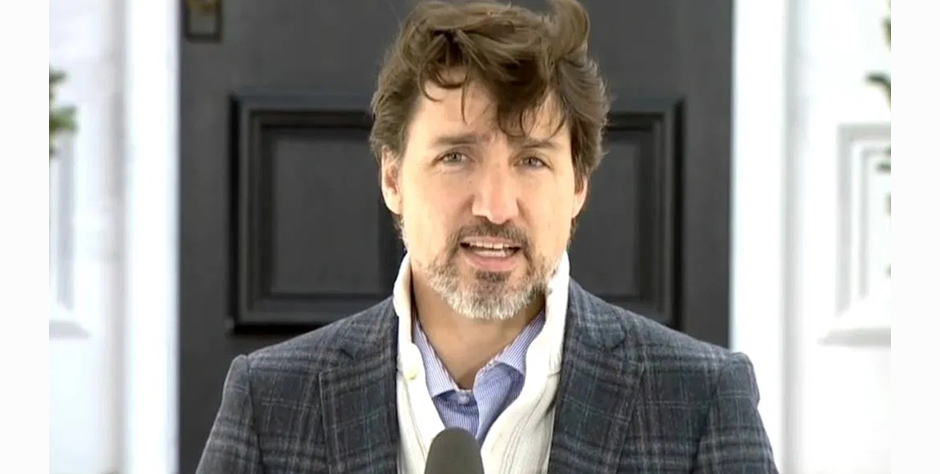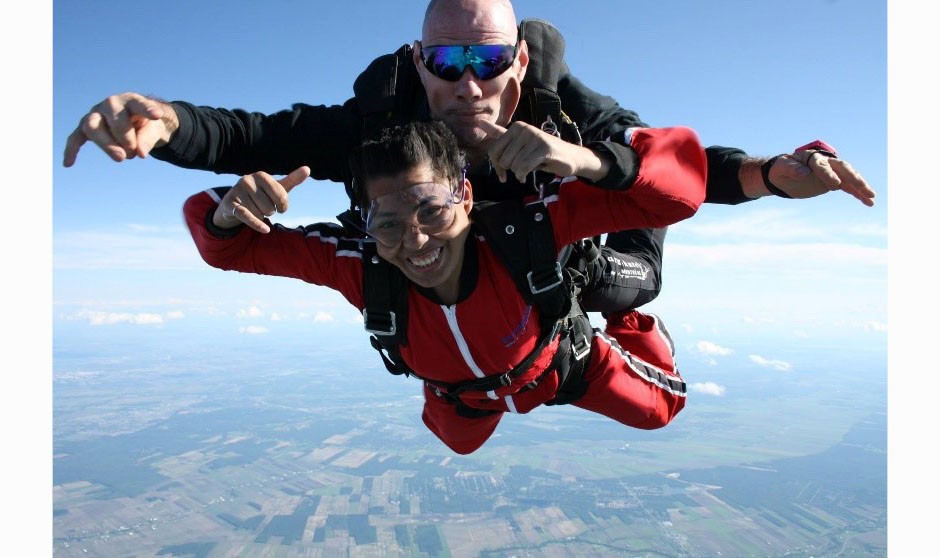Keroles Riad is a doctoral candidate in the Individualized program (INDI). Keroles holds a BEng in Mechanical engineering and an MSc through the INDI program. Keroles is a recipient of the Quebec Lieutenant Governor Youth Medal, and is the driving force behind Concordia’s successful Waste Not, Want Not student-led composting program.
Blog post
It is a really bad time for photoshoots
 Picture from Global News: https://globalnews.ca/news/6838958/coronavirus-trudeau-update-april-19/
Picture from Global News: https://globalnews.ca/news/6838958/coronavirus-trudeau-update-april-19/
I am an experimentalist. I experiment in my research; I experiment in my side projects like Waste Not, Want Not; I experiment in my life. That included jumping out of an airplane at 10,000 feet, the day before the convocation ceremony of my bachelor’s in Mechanical engineering from here at Concordia. In my last blog, I mentioned that my research includes regularly lighting flammable chemicals on fire (very satisfying).
Waste Not, Want Not actually announced the cancellation of our events a few days prior to the day that the Quebec Government ordered the shutdown of universities, which in turn cancelled all on-campus events. I also live with a chronic health condition that involves regular hospital visits, and included a couple of major surgeries. All to say, I am not foreign to risk and safety. In fact, I have blogged the occasional rant on common missteps when it comes to lab safety. I have also co-designed a hands-on safety training for undergraduate students with the EH&S department at Concordia, for which I received the Safety Champion award. I believe that the pandemic and reopening contexts in which we live today make it important for everyone in society to develop a safety mindset and the skills needed to think about risk. With that, I would like to share some of my thoughts and learnings:
Understand risk, do not just be afraid of it
If tomorrow you only remember one thing from this blog, this is the one. It is a quote from a video that Canadian astronaut, Col. Chris Hadfield (the one with the guitar), has posted at the beginning of this pandemic. An example of what happens when we blindly fear risk we do not understand is how coffee chains and grocery stores started to refuse to allow their customers to bring their own reusable mugs, bags or containers. This is unjustified and has no ties to actual safety. About a 120 scientists, academics and doctors from 18 countries concurred in a statement that reusables have similar risk to disposable items, and that fundamentally what is needed is basic hygiene. Recently, I conducted a poll on Waste Not, Want Not’s Facebook and Twitter asking if people found that their personal waste increased or decreased during the pandemic. After 168 votes, and about 50 comments, ~60% of people said that their personal waste increased often citing how stores no longer allow them to bring their reusable bags and containers. The only thing this blind fear does is create a lot of waste that ends up in landfills and oceans.
Be reasonable
This is especially important for managers trying to implement procedures and rules for safe operations in businesses, institutions and research labs. An imaginary scenario I sometimes think of is if you ask how to cross the street safely. A reasonable person would say that you should look left then right and then cross the street if there are no cars coming. If it is a highway, try to find a tunnel or a pedestrian overpass. An undue request would be to build an Ironman suit. It is difficult to argue with undue requests, because of course you would be safer (and maybe cooler) crossing the street in an Ironman suit. But it is unjustified. To be blunt, extreme measures with no clear safety justification are just meant to be broken behind your back. What is worse, people will never feel comfortable asking you for advice when they need to do something that has actual risk for fear they will be required to comply with extreme liability-driven measures. Undue requests simply erode trust, discourage advice seeking, and make everyone unsafe.
Be kind
Only 10% of infected people are responsible for over 80% of new infections, according to a recent article in the New York Times. The reality is that most people with COVID-19, will not spread it. The more important point is that the 10%- “the super-spreaders”- are the ones that engage in activities like going to crowded parties, bars, rallies, etc. These are not the people who are following public health guidance imperfectly; they are the ones completely ignoring it. So, help your colleagues and neighbors improve their habits and be kind at the same time. People who are trying, even if they are making mistakes, are not the problem.
Be trustworthy
Whether you are working in communication or a leadership position, it is never your job to manipulate people’s perception. This is true in every situation and particularly during crisis. Your community needs to know that they can trust you leading them through hard times, and that means they need to believe every word you say. That means that you must always tell people the truth unvarnished and free of all forms of spin. This is true even if what you say is not something that makes you look good, or not something they are happy to hear. The evolution of guidance on mask wearing for the public is a clear example of perception-driven communication that has backfired. At the beginning, we were told that masks are not designed to protect the wearer but others around them, and at the same time we were told about how critical they are to protect healthcare workers that need to wear them. Why would me wearing a mask only protect me if I were a healthcare worker? The truth is that masks provide more protections to others, and they also provide some protection to the wearer. Erosion of trust, and the delay in getting the public to wear non-medical masks cost lives.
Masks work- imperfectly. We must reserve medical masks for health care workers because if they get sick no one can take care of me, of my family. Please wear non-medical masks especially when you cannot keep a 2-meter distance from everyone else.
Additionally, to earn people’s trust, you should talk to them about their safety, not your liability. In other words, a safety training should not feel like the waivers I signed before jumping out of an airplane.

Safety is not a photoshoot
Personal protective equipment is meant to be worn when they are necessary because you cannot eliminate risk or install engineering controls. They are not photo props that you need to see in every picture of someone in a workplace. In every workplace the fundamental rule is that you only come to work when you absolutely must. If you can work from home, then you should work from home. If you must come to work, then you must always try to stay at least 2-meters away from everyone else. You should also wear a non-medical mask indoors and especially when physical distancing is impossible. A photoshoot mentality is essentially akin to asking you to wear masks while alone at home. You need to understand when personal protective equipment is necessary, and know how to use them properly.
These are my thoughts on risk and safety. But I have a little sidebar. Other things that are not photoshoots include diversity, and sustainability.
Members of the #CUcompost waste ambassadors team speak over nine languages between them. I am extremely proud to be a part of one of the most diverse teams working on sustainability at Concordia. This was not intentional; it simply turns out that when we are focused on commitment, competency and work ethic, we also benefit from diversity. As a person of color myself, I am also keenly aware that people of color and indigenous peoples have been the dominant voices leading by example the fight against the waste and climate crises for centuries. Yet, the contemporary environmental movement has often ignored them. Suffice to note that Canadians throw away 58% of the food they buy, almost double the global average at 33%. To suggest that people of color here in Canada and across the globe have not been leading by example in fighting the climate and waste crises is delusional. Moving forward must be substantive, and not a photoshoot.
I have also been disturbed by the growing trend treating sustainability as a photoshoot. I lost count of how many times I was in a picture and had to worry about having any kind of plastic items around, mine or not. The trade-offs between plastic, cotton and paper bags are a good example. Considering the full life cycle environmental impact, including production, this becomes complicated. Paper bags consume more energy and water, and emit more greenhouse gases to produce than disposable plastic bags. Similarly, you will need to reuse a cotton bag 131 times to match the environmental impact of a 131 disposable plastic bags. Of course, 131 plastic bags cause a lot of litter that mostly end up in our oceans and then our food supply, which is no good. The bottom line is that you should reuse whatever bag you already have. That means we need to get over the photoshoot mentality of worrying that reusing a plastic bag does not “look” as sustainable as we would like.
Crises like COVID-19, racism, waste, climate change are strong forces that should drive us to come together, rebuild trust and stay focused on what matters not what looks good. As a society, we must re-embrace science, evidence-based policy and common sense.
About the author


